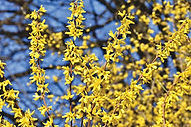June

Much as I love springtime, summer begins in a blaze of glory this month showing all the hard work has been worthwhile. Colour runs through the greenery of the trees and bushes, bees are buzzing and birds are whizzing back and forth filling their bellies with flying insects. Everything has now woken up and, hopefully, enjoying the sunshine. There is still work to be done, though, but I never mind that!
Shrubs

Spring flowering shrubs should be pruned by about a third to encourage new shoots for next year and, as always to make for an open, airy bush so that light can get right in. Cut out any damaged or dead stems and clear weed growth around the base then mulch with a good compost as this will not only deter weeds, but also feed the soil. Keep an eye on any rambling or climbing roses as these will be galloping ahead this month and will need to be tied in to ensure the plant doesn’t fall forward once the heavy blooms are abundant.

Cuttings

Annuals

Perennials

June is a good time to take softwood cuttings, a job I always find so satisfying. With a sharp blade, cut just below a node 3-5” long and at a slant. Remove any lower leaves and pinch out the soft tip. Dip the bottom into some rooting hormone and shake off the excess. Push 4 or 5 into a 6” or 8” pot filled with cuttings compost around the sides and water in. Keep moist, but not wet. Once the new roots show out of the base of the pot, the plantlets can be potted on to individual pots.

Summer annuals can be planted out now that there is little danger of frost. I've said before that I prefer scattered groups of annuals rather than straight rows, but it is a personal choice as to how they're planted. The only place I plant some low growing annuals in a line is at the front of tall wood containers along the back of my veggie plot with the sweet peas - and even that line is staggered! I do think, though, that loads of allysum planted along a stone path can look stunning as the flowers scramble over and soften the edges. Pinching out the growing tips will encourage bushier plants and regular deadheading will promote fresh blooms. In really dry weather, a good watering in the evening will help maintain their lushness and, every now and again, give them a dose of liquid fertiliser. As always, though, try not to over-water.

Tie in taller growing perennials, like delphinium and lupin, to stakes to prevent drooping over other, smaller plants. Cut back spring flowering ones as this could encourage new growth. Continue to put mulch around the base of plants to retain moisture where it is needed; best done after watering in the early morning or late evening. Seek out something new at the nursery or garden centre to give your garden a fresh perspective - or beg a friend for a cutting of theirs!

Containers

If not done last month, there is still time to plant up containers. Make sure the compost you're using is newly bought in this year or that half of the old compost has been removed and new then mixed in. If topping up the old compost, It's a good idea to also give the whole a good drenching of diluted liquid fertilizer and left at least twentyfour hours before planting up. Container planting really gives an opportunity to be flamboyant with colour - or, indeed, calming colours if that's your preference.

Vegetables
In the vegetable plot mulch around the base of beans, peas, courgettes, etc to aid water retention. Keep an eye on autumn planted garlic as, once the leaves start to turn yellow, they can be harvested and stored. Early potatoes can also be harvested, though, as I don't grow main crop potatoes, I tend to leave mine in the ground and help myself as and when I need them. Continue thinning out salad crops and root vegetables, removing any weed seedlings that may have appeared and sow fresh seeds for a continuous supply.
Keep checking tomato plants and make sure you nip out new growth in the axis of stem and leaf stalk as these produce nothing and take goodness away from the main plant and ultimate fruit. Feed once a week once flowers appear and continue to tie into the stake as the plant grows. Stop the plant producing new growth once you have 4-5 trusses by nipping out the growing tip.

Here in my Village, we are running The Great Pumpkin Contest. Quite a number, having collected and sown their seeds, should now be safely planting out the young seedlings in their chosen spot that should be open and sunny in a mound of well rotted manure and compost. Care should be taken not to disturb the roots too much when planting. Pumpkins need plenty of water over their growing time, but be careful not to allow the area around the main stem to get waterlogged as this could cause rot.

It's lovely to sit out again in the warm evenings, glass to hand, listening to the birds chirruping and, very soon, I will have a new addition to my pet family - you'll meet Martha next month...

